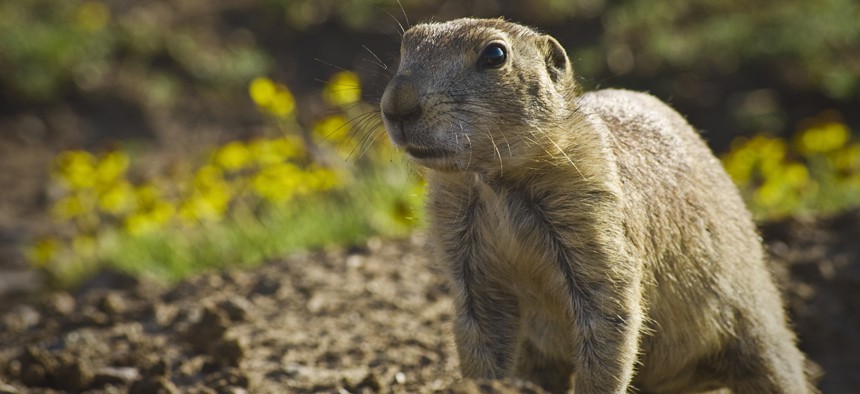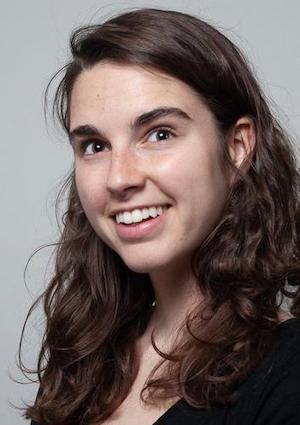A State Wildlife Agency That's Winning at Twitter

Prairie dog looking at sunrise in Wichita Mountains National Wildlife Refuge, north of Lawton, Oklahoma. Justin A. Morris via Getty Images
Oklahoma's Department of Wildlife Conservation has grown its follower count from around 8,000 to over 80,000, dishing out posts that are fun but also informative. The agency's social media team chatted with Route Fifty about the secrets to their success.
What do bucket-hat-wearing rodents, the animated character Shrek, and state regulations all have in common? You can get a hefty dose of each with a quick scroll through the Oklahoma Department of Wildlife Conservation’s Twitter feed.
With more than 80,000 followers on the platform, the department’s social media team has won a handful of awards, including Best Twitter Presence at this year’s Government Social Media Conference in Dallas. With humor, sass, competitive quizzes and practical information, the page’s content runs the gamut. And while some tweets may seem a bit off-the-cuff, there’s thoughtful collaboration behind every post.
Route Fifty talked with the department’s social media coordinator Sarah Southerland and webmaster Daniel Griffith about the page’s rapid growth, how they brainstorm ideas and some of the more difficult aspects of the work.
This conversation has been edited for brevity and clarity.
Could you start by sharing a bit about your backgrounds?
Sarah Southerland: I've been at the wildlife department for two years. I came from a podcasting background here with the Oklahoma City Thunder and ended up coming on the wildlife department in 2020.
I was always kind of an outdoorsy person. And when this position came available, I showed interest. And they never had a social media coordinator before. So it was kind of like a new, a new journey for everybody. Even though we were all kind of taking a leap of faith together, it worked out.
Daniel Griffith: I've been with the agency almost 17 years working within our communication [and] education division that whole time, and in the last few years have actually taken over the role as our webmaster just handling content [for] our website.
I grew up outdoors, hunting, fishing, and stuff like that, and just wanted to find some way that I could contribute within the agency. So that's kind of what I've been doing and how I got here.
Could you talk about how the Twitter account has evolved over the last few years?
Southerland: I kind of inherited this Twitter account that has been historically a problem child for our agency. And honestly, Twitter is very hard for government agencies.
But we started developing our voice, and I have the written plan from 2020 that outlines how we're going to change our Twitter voice. And it was just the bullet point plan of like step one, step two, step three.
The biggest step was to change the language that we use, and step away from kind of this foreign government speech habit, and start talking more like the Oklahomans around us. [We] adopted a voice that is very similar to how we speak to each other and how we speak in the office.
And then from there, we got more and more engagement.
***
I'm the coordinator, so I'm kind of the [point-person] for all of it. But the people on our team, like Daniel—he's wildly different than me. We're separated by age and he's a dad. And everybody on the social media team is a very different person [with] very different personalities. And it really worked together very well, so that collaboration is probably the biggest takeaway from that.
***
My first year coming on, I had to learn everything about the agency. And [it took] about a year until I was like, okay, let's start implementing some social media plan. But that whole year of learning what we do and ... all [the] facets of a 350-person agency that keeps fish and wildlife conservation in the state running is a lot of effort.
So we started at, like, 8,000 followers. And now we're at like, 81,000. But yeah, there was a struggle bus. So when I say it was the problem child, it really did it just kick our booties.
Griffith: I've been a little involved with Twitter [since] before Sarah came on. But, you know, prior to that there was not one specific person focused on social media, there was a handful of people who may have been somebody whose responsibility was our magazine and news releases and publication stuff, [or] maybe one of our guys who handles our TV production. I mean, we had a handful of people that do specific things that were all contributing, and it was like, we each had a day, and the only time we really worried about social media was on our day.
But now we have Sarah who's specifically focused on keeping things going, and created that voice for us.
So I might have a really bad dad joke. But she's going to twist it to where it appeals to our audience or change it to where it goes out [in] her voice, instead of coming out in my, probably boring, dad voice.
That's, I think, the key. We've got multiple people contributing. And one person is kind of taking all those ideas, and making sure that they all stay in line with each other versus how we used to do in the past.
How many people are on the social media team?
Griffith: There's at least five of us. We have different levels of contribution. Some of us actually have a day where we're answering [direct messages] or private messages that are coming in. And then for instance, [one person] just throws ideas out there, helps look at, you know, tweets or posts and stuff. And they contribute a post here and there.
What is your process for creating the department's Tweets?
Southerland: So what we have is this pretty janky whiteboard where people walk by my desk and write down just dumb things. Like I think the phrase “donut plugs, not holes” is written on there right now.
And then we go from there; our boss will send us emails, we have contests. We have people within our education division who send us, like, the meatier topics of what's going on with research within [the] agency, like how are different projects doing. Everyone really, really contributes, and then we reward that contribution by actually using it. We're not pretentious about what we put on the Twitter account, because it's a group project.
I think sometimes when people interview us, they expect to be talking to, like, marketing geniuses or a giant agency team. And we're not—we’re just a group of government employees.
Griffith: All of us have ideas. And basically, we either twist somebody's idea or edit it. And then of course, Sarah massages it to be in our voice. So it is a big team effort.
And there's no bad ideas. It's like, yeah, we may not use something, but I might have an idea and then either Sarah or our supervisor will explain, ‘hey, this is why we're not doing that.’
Has there been any pushback? Was there ever a point where your supervisors said, “This is too out there, let’s reign it in?”
Southerland: The pushback that we did get was from people outside [the agency]. Like, people on Twitter who really felt like it was their responsibility to bully us back into their expectations of how government social media needs to sound and look like. And I think just people naturally a) don't like the government and b) don't like change. And so when you do both, you're going to get some pushback.
I believe we got a lot of really great support from the people higher up around here, where our supervisors and bosses have all fielded several phone calls complaining about us. They have all been troopers and great about it. I don't think you can do what we do without people who are willing to go to bat for you and that I'm so grateful for.
Griffith: I mean, they get one phone call with somebody who’s worried about it. But then that specific post or something maybe had 15, 16,000 likes. I mean, I think anything we've done that's new, like Sarah is saying, there's gonna be people who don't like [the] change.
What are some of the more difficult parts of the job today now that you're up and running?
Southerland: I try to make sure that everybody on the social media team feels valued and that they are also not being a victim our Twitter or of our TikTok or of the demands of [social media]. Because our Facebook is still insanely active in our direct messages with people with very important questions that we have to get to and our Instagram is still insanely active with people with very important questions.
And then you have this whole audience of people on Twitter, if you open that tab, is people just screaming at you. And then you have TikTok over here, which is like the kids screaming at you. So if it's your social media day, you can get so overwhelmed. But I'm always there, obviously… [to be] like hey, by the way, I know you've volunteered to help do this. Let's get you focused on something that you want to do.
My expectation of myself and everybody around me is that we're not, like, the hype house. We're not influencers. We're people who really liked wildlife conservation and more communicators, those keeping it in that lane.
Griffith: Feeding the beast.
I think the expectation–and Sarah probably feels this the most out of all of us–is that now that we're rolling, there's this expectation to maintain it and to maybe even do better. It creates maybe a little extra stress than it was before. So just maintaining and keeping up the good work. But it's a lot of fun.
Has the increased Twitter following had any kind of real-world impact?
Sutherland: So back in 2020, there was a huge boost of people getting outdoors because nothing, we were in a shutdown. And there was a pandemic. And our big slogan for that year was, “the outdoors are always open.” So of course, we saw that huge boost of people.
So part of this Twitter plan did consider those new people out there. And we really needed a space to a) ask them questions and b) put out pretty remedial information for these new users. So we did see that initial boost, right when this quote-unquote project started. And then now what we do is basically try to educate people about the role of conservation, and kind of a wider sense of what it means in Oklahoma.
Griffith: I’m in charge of website content. Before that, for like 14 years, I was on the education side of our communications.
Education is always in my focus, and a lot of stuff I see us do, I want to educate [our audience]. And I hear a story from Sarah about someone over in the UK, who had no idea that salamanders are real, they thought they were some Harry Potter imaginary creature. But they are real!
So in this instance, it’s not just Oklahomans. We're connecting with the whole world and educating them.
Molly Bolan is the assistant editor for Route Fifty.
NEXT STORY: As State Institutions Close, Families of Longtime Residents Face Agonizing Choices






